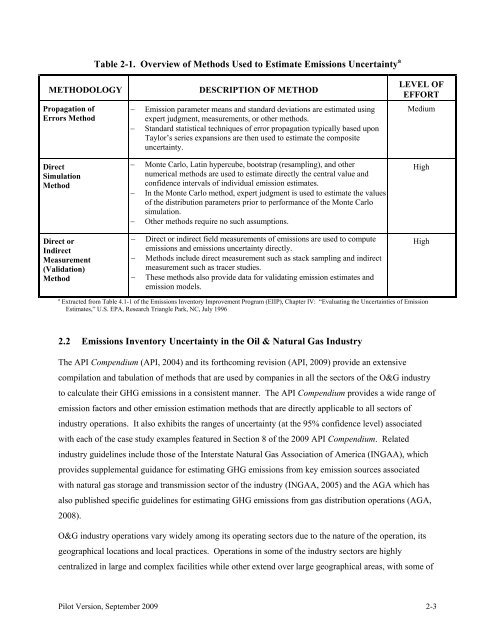addressing uncertainty in oil and natural gas industry greenhouse
addressing uncertainty in oil and natural gas industry greenhouse
addressing uncertainty in oil and natural gas industry greenhouse
Create successful ePaper yourself
Turn your PDF publications into a flip-book with our unique Google optimized e-Paper software.
Table 2-1. Overview of Methods Used to Estimate Emissions Uncerta<strong>in</strong>ty a<br />
METHODOLOGY<br />
DESCRIPTION OF METHOD<br />
LEVEL OF<br />
EFFORT<br />
Propagation of<br />
Errors Method<br />
−<br />
−<br />
Emission parameter means <strong>and</strong> st<strong>and</strong>ard deviations are estimated us<strong>in</strong>g<br />
expert judgment, measurements, or other methods.<br />
St<strong>and</strong>ard statistical techniques of error propagation typically based upon<br />
Taylor’s series expansions are then used to estimate the composite<br />
<strong>uncerta<strong>in</strong>ty</strong>.<br />
Medium<br />
Direct<br />
Simulation<br />
Method<br />
−<br />
−<br />
−<br />
Monte Carlo, Lat<strong>in</strong> hypercube, bootstrap (resampl<strong>in</strong>g), <strong>and</strong> other<br />
numerical methods are used to estimate directly the central value <strong>and</strong><br />
confidence <strong>in</strong>tervals of <strong>in</strong>dividual emission estimates.<br />
In the Monte Carlo method, expert judgment is used to estimate the values<br />
of the distribution parameters prior to performance of the Monte Carlo<br />
simulation.<br />
Other methods require no such assumptions.<br />
High<br />
Direct or<br />
Indirect<br />
Measurement<br />
(Validation)<br />
Method<br />
−<br />
−<br />
−<br />
Direct or <strong>in</strong>direct field measurements of emissions are used to compute<br />
emissions <strong>and</strong> emissions <strong>uncerta<strong>in</strong>ty</strong> directly.<br />
Methods <strong>in</strong>clude direct measurement such as stack sampl<strong>in</strong>g <strong>and</strong> <strong>in</strong>direct<br />
measurement such as tracer studies.<br />
These methods also provide data for validat<strong>in</strong>g emission estimates <strong>and</strong><br />
emission models.<br />
High<br />
a Extracted from Table 4.1-1 of the Emissions Inventory Improvement Program (EIIP), Chapter IV: “Evaluat<strong>in</strong>g the Uncerta<strong>in</strong>ties of Emission<br />
Estimates,” U.S. EPA, Research Triangle Park, NC, July 1996<br />
2.2 Emissions Inventory Uncerta<strong>in</strong>ty <strong>in</strong> the Oil & Natural Gas Industry<br />
The API Compendium (API, 2004) <strong>and</strong> its forthcom<strong>in</strong>g revision (API, 2009) provide an extensive<br />
compilation <strong>and</strong> tabulation of methods that are used by companies <strong>in</strong> all the sectors of the O&G <strong>in</strong>dustry<br />
to calculate their GHG emissions <strong>in</strong> a consistent manner. The API Compendium provides a wide range of<br />
emission factors <strong>and</strong> other emission estimation methods that are directly applicable to all sectors of<br />
<strong>in</strong>dustry operations. It also exhibits the ranges of <strong>uncerta<strong>in</strong>ty</strong> (at the 95% confidence level) associated<br />
with each of the case study examples featured <strong>in</strong> Section 8 of the 2009 API Compendium. Related<br />
<strong>in</strong>dustry guidel<strong>in</strong>es <strong>in</strong>clude those of the Interstate Natural Gas Association of America (INGAA), which<br />
provides supplemental guidance for estimat<strong>in</strong>g GHG emissions from key emission sources associated<br />
with <strong>natural</strong> <strong>gas</strong> storage <strong>and</strong> transmission sector of the <strong>in</strong>dustry (INGAA, 2005) <strong>and</strong> the AGA which has<br />
also published specific guidel<strong>in</strong>es for estimat<strong>in</strong>g GHG emissions from <strong>gas</strong> distribution operations (AGA,<br />
2008).<br />
O&G <strong>in</strong>dustry operations vary widely among its operat<strong>in</strong>g sectors due to the nature of the operation, its<br />
geographical locations <strong>and</strong> local practices. Operations <strong>in</strong> some of the <strong>in</strong>dustry sectors are highly<br />
centralized <strong>in</strong> large <strong>and</strong> complex facilities while other extend over large geographical areas, with some of<br />
Pilot Version, September 2009 2-3

















